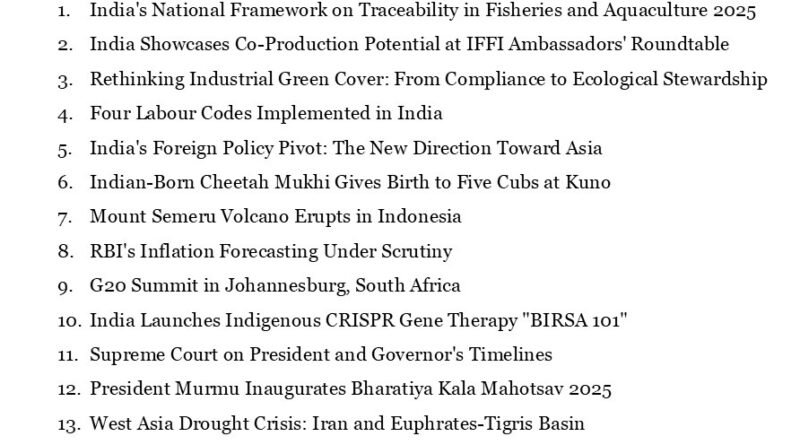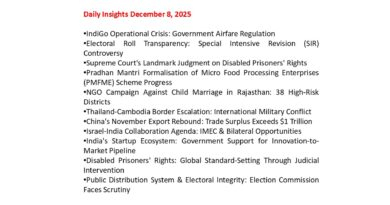Daily Insights November 22, 2025
Contents
Daily Insights November 22, 2025
1. India’s National Framework on Traceability in Fisheries and Aquaculture 2025
Source: PIB Press Release
Key Points:
India unveiled the “National Framework on Traceability in Fisheries and Aquaculture 2025” on World Fisheries Day (November 21, 2025)
India’s fish production has doubled from 96 lakh tonnes to 195 lakh tonnes over the past decade with an investment of ₹38,572 crores under schemes like PMMSY
India aims to scale seafood exports to ₹1 lakh crore by 2030, with 30% comprising high-value, value-added products
Fisheries sector is expanding at 9% annually with seafood exports reaching 16.85 lakh tonnes in FY 2024-25 – an 88% increase over the past decade
Government focusing on value addition, diversification, and regulatory compliance including Marine Mammal Stock Assessment Project and adoption of Turtle Excluder Devices (TEDs)
2. India Showcases Co-Production Potential at IFFI Ambassadors’ Roundtable
Source: PIB Press Release
Key Points:
Ambassadors’ Roundtable held at IFFI 2025 on November 21, 2025, at Taj Cidade de Goa Heritage Hotel, Dona Paula
Session explored bilateral audio-visual cooperation, co-production opportunities, creative-economy growth, and cultural exchange
India’s media and entertainment sector projected to touch USD 31.6 billion in 2025, fuelled by exponential growth in VFX, animation, and production technologies
Dr. L. Murugan highlighted bilateral agreements enabling joint development ventures, smoother mobility of talent and resources, and increased creative freedom
India strengthening anti-piracy measures through inter-ministerial collaboration with MeiTY, MHA, and Ministry of Law
Ambassadors of Cuba, Nepal, and senior diplomats from Israel, Guyana, Australia, Ireland, Morocco, Togo, and Côte d’Ivoire participated
3. Rethinking Industrial Green Cover: From Compliance to Ecological Stewardship
Source: The Hindu Editorial
Key Points:
Global trend of relaxing industrial green-cover norms in the name of “ease of doing business” often overlooks ecological context and long-term sustainability
On-site green belts reduce particulate matter by up to 65% and noise by 10-17 decibels but cannot replicate natural ecosystem services like carbon sequestration, biodiversity support, and habitat connectivity
International comparisons of green-cover requirements are misleading without considering population density, ecological resilience, and industrial intensity
Sustainable approach lies in landscape-scale greening: allowing partial relaxation of on-site requirements while mandating off-site ecological commitments
Industries should become ecological stewards by developing regional green reserves, restoring degraded lands, enhancing ecological corridors, and participating in biodiversity offset programs
Future of sustainable industrial development depends on linking industrial progress with ecological regeneration at landscape level, not just counting trees inside factory gates
4. Four Labour Codes Implemented in India
Source: PIB Press Release
Key Points:
Government implemented four Labour Codes effective from November 21, 2025, replacing 29 Central labour laws
Four Codes: Code on Wages (2019), Industrial Relations Code (2020), Code on Social Security (2020), and Occupational Safety, Health and Working Conditions (OSHWC) Code (2020)
Extends statutory rights such as minimum wages, timely wage payment, and appointment letters to all workers
ESI benefits available pan-India, can apply to establishments with even one employee in hazardous work
Recognizes gig and platform workers with aggregators required to contribute revenue share to social security fund
Women permitted to work night shifts across sectors including mines and hazardous industries with safety measures
Fixed-term employees receive benefits on par with permanent workers, including gratuity after one year
5. India’s Foreign Policy Pivot: The New Direction Toward Asia
Source: The Hindu Editorial
Key Points:
India at foreign policy crossroads as 21st century’s power center shifts to Asia, evidenced by SCO Summit dynamics (Putin-Modi-Xi engagement) and G20 Johannesburg Summit
India should avoid U.S.-framed binary choice between Washington and Beijing; adopt “trust but verify” approach with China on Ladakh border negotiations
Asia offers combined market surpassing U.S., with integration evolving through shared value-chain interests rather than colonial legacies
India should reconsider joining RCEP to diversify markets away from U.S. and negotiate pragmatic trade arrangements with China outside WTO constraints
Strategic autonomy must reflect India’s unique position: fastest-growing economy with largest labour force yet highest poverty, aligning with Global South interests
Technological interdependence now determines power; non-negotiable priorities include national data protection, domestic innovation, local defence manufacturing, and inclusive growth
Cyber warfare should become backbone of national security over traditional theatre commands; India needs 20-fold increase in AI funding to achieve AI sovereignty by 2047
Geopolitical shifts: China scaled back CPEC, U.S. expanded influence in Bangladesh, India secured Chabahar Port sanctions waiver maintaining strategic access to Central Asia
6. Indian-Born Cheetah Mukhi Gives Birth to Five Cubs at Kuno
Source: Indian Express Editorial
Key Points:
First Indian-born cheetah Mukhi (33 months old) gave birth to five cubs at Kuno National Park, Madhya Pradesh
Historic milestone for Project Cheetah, proving cheetahs born in India can adapt, thrive, and breed in Indian habitats
Birth marks second-generation cheetahs born in India since species reintroduction in September 2022 after 70-year extinction
Madhya Pradesh’s cheetah count now stands at 32 (29 at Kuno, 3 at Gandhi Sagar)
Despite challenges including loss of nine imported adults and ten cubs, survival rate exceeds 61% (global average 40%)
Major success for species adaptation, health, and long-term viability in Indian ecosystems under PM Modi’s conservation leadership
7. Mount Semeru Volcano Erupts in Indonesia
Source: News Reports
Key Points:
Mount Semeru, Indonesia’s tallest peak on Java island, erupted on November 19-20, 2025, at around 2 PM local time
Ash plume rose over 6,500 feet (approximately 2 km) above summit, with pyroclastic flows traveling 7-8.5 km from summit
Indonesian government declared Level 4 (Awas) alert, the highest volcanic warning level
300 residents evacuated from nearby villages; about 178 climbers (including porters and guides) safely evacuated
Volcanic clouds covered bridges and villages with hot ash; two individuals on Gladak Perak Bridge sustained burns
Mount Semeru has erupted 2,802 times in 2025 alone; located in Pacific Ring of Fire
Devastating 2021 eruption killed 62 people and buried villages under hot ash
8. RBI’s Inflation Forecasting Under Scrutiny
Source: Economic Reports
Key Points:
RBI’s inflation forecasting model under scrutiny after consistently overestimating price pressures in 2025
India’s retail inflation (CPI) dropped to 0.25% in October 2025, lowest since new CPI series began in 2013
RBI’s projection of 2.6% inflation for fiscal year (published in October) already outdated; UBS economist predicts 2-2.2% for current quarter
Main reason for forecast errors: sharp drop in food prices due to strong harvests after favorable monsoon and improved supply chain management
Food prices contracted record 5.02% year-on-year in October 2025; food comprises 46% of CPI
RBI’s mandate: keep inflation at 4% with tolerance band of 2-6%
Ultra-low inflation raises concerns about weak consumer demand and potential economic slowdown
Experts suggest need for fiscal policy intervention to revive demand
9. G20 Summit in Johannesburg, South Africa
Source: UN and G20 Reports
Key Points:
20th G20 Leaders’ Summit held in Johannesburg on November 22-23, 2025 – first G20 summit on African soil
Theme: “Solidarity, Equality, Sustainability” under South Africa’s Presidency
PM Modi attended representing India; US President Trump skipped the summit citing discredited claims about South Africa
Key agenda: inclusive economic growth, climate change, just energy transitions, food systems, critical minerals, decent work, and artificial intelligence
UN Secretary-General called for tripling adaptation finance to $40 billion and mobilizing $300 billion per year by 2035 for developing countries
Summit addressed crushing debt burdens, shrinking fiscal space, and multilateral development bank reforms
India participated in IBSA (India-Brazil-South Africa) Leaders’ Meeting
China positioned itself as problem-solver and provider of issue-based leadership on digital economy and AI governance
10. India Launches Indigenous CRISPR Gene Therapy “BIRSA 101”
Source: Health Ministry Reports
Key Points:
India launched first indigenous CRISPR-based gene therapy “BIRSA 101” for Sickle Cell Disease on November 19, 2025
Named in honor of tribal freedom fighter Birsa Munda (150th birth anniversary recently observed)
Developed at CSIR–Institute of Genomics & Integrative Biology (IGIB) using enFnCas9 CRISPR platform
Technology transfer agreement signed between CSIR-IGIB and Serum Institute of India for large-scale, cost-effective production
Phase 1 clinical trials involved three patients funded by Department of Science & Technology and Ministry of Tribal Affairs
Indigenous therapy priced at fraction of global treatments (international treatments cost Rs 20-25 crore)
Targets tribal populations in central and eastern India where disease burden is highest
Part of PM Modi’s vision for Sickle Cell Disease-free India by 2047
Demonstrates India’s Atmanirbhar Bharat capabilities in frontline medical technologies
11. Supreme Court on President and Governor’s Timelines
Source: The Hindu Editorial
Key Points:
Supreme Court ruled on November 21, 2025, that judiciary cannot tie President and Governor to timelines for Bills
CJI B.R. Gavai (retiring November 23) wrote separate opinion warning that May 2025 judgment would cause huge economic damage
Ruling reinforces constitutional autonomy of executive, checks judicial overreach, and reaffirms basic structure balance
CJI argued that retrospective environmental clearances removal would demolish major government and private projects causing massive unemployment
Justice Ujjal Bhuyan dissented in 97-page opinion, stating recall went against environmental protection principles
Judgment clarifies Articles 200-201 asserting separation of powers and discretionary functions
Case addresses balance between judicial review and executive prerogative in federal relations
12. President Murmu Inaugurates Bharatiya Kala Mahotsav 2025
Source: PIB Press Release
Key Points:
President Droupadi Murmu inaugurated 2nd edition of Bharatiya Kala Mahotsav at Rashtrapati Nilayam, Secunderabad on November 21, 2025
Nine-day festival (November 22-30, 2025) organized by Rashtrapati Nilayam with Ministry of Culture, Textiles, and Tourism
Showcases rich cultural heritage of Gujarat, Maharashtra, Rajasthan, Goa, Dadra & Nagar Haveli, and Daman & Diu
First edition focused on Northeast India; 2025 edition highlights Western India’s folk traditions
Features over 250 artists including Padma Shri awardees presenting classical and folk dance performances
Cultural segment “Pashchimalap” includes Dhol-Tasha (Maharashtra), Kalbelia (Rajasthan), Talvaar Raas Garba (Gujarat), and Samai (Goa)
Open to public 10 AM-8 PM; entry free with online booking at https://visit.rashtrapatibhavan.gov.in
Governor of Telangana, Union Culture Minister Gajendra Singh Shekhawat, and other dignitaries attended
13. West Asia Drought Crisis: Iran and Euphrates-Tigris Basin
Source: World Weather Attribution Report
Key Points:
Iran and Euphrates-Tigris basin experiencing fifth consecutive year of drought (2020-2025)
Tehran faces potential evacuation by mid-December 2025 if no rainfall occurs; 10+ million residents affected
Iran’s rainfall decreased 89% compared to long-term average, making autumn 2025 driest in 50 years
Iraq recorded driest year on record since 1933; water levels in Tigris and Euphrates dropped 27%
Syria’s rainfall fallen 70%, crippling 75% rain-fed farmland with wheat shortfall of 2.73 million tonnes
Agriculture consumes over 90% of Iran’s water; dams at critical levels (32 dams with less than 5% capacity)
Iran conducting cloud seeding operations using aircraft and drones; government adopted National Climate Change Management Plan in October 2025
Human-induced climate change combined with socio-economic water stressors increased drought severity
FAO launched Regional Cooperation Project for climate-resilient agriculture and improved water management
14. Supreme Court Directs National Tribunals Commission Formation
Source: Legal Reports
Key Points:
Supreme Court directed Union Government to constitute National Tribunals Commission (NTC) within four months
Bench comprising CJI BR Gavai and Justice K Vinod Chandran passed direction in Madras Bar Association case
Court struck down Tribunal Reforms Act, 2021, citing violations of constitutional principles of separation of powers and judicial independence
Tribunal Reforms Act provisions diluted judiciary’s role in appointments, tenure, and service conditions of tribunal members
Court emphasized executive has constitutional obligation to set up NTC as repeatedly mandated in earlier judgments
Ruling reinforces that tribunal members should be independent persons, not civil servants, resembling courts rather than bureaucratic boards
Court invalidated provisions allowing Group A post holders or Joint Secretaries to be appointed as Technical Members
Decision strengthens fundamental principle that tribunals require independence from sponsoring/parent departments
15. India Develops Indigenous Gene Editing Technology for Crops
Source: Indian Express
Key Points:
Indian scientists developed “miniature alternative” to CRISPR-Cas technologies using TnpB proteins
Offers fully indigenous genome-editing tool for plants, addressing commercialization hurdles due to CRISPR patent restrictions
Marks major step in Atmanirbhar Bharat biotech innovation allowing low-cost GM crops without foreign patents
Technology enables indigenous gene-editing platform free from international intellectual property constraints
Links to Genetic Engineering Appraisal Committee (GEAC) and bio-safety guidelines for food security goals
Development comes as India faces patent barriers preventing commercialization of CRISPR-edited crop varieties
Indigenous breakthrough positions India for self-reliant agricultural biotechnology advancement
Technology transfer potential for affordable, scalable gene-edited crop development benefiting farmers
Discover more from Simplified UPSC
Subscribe to get the latest posts sent to your email.


